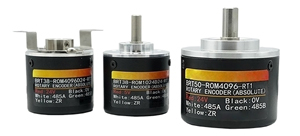Absolute Encoder Working Principle
Absolute rotary encoders have been more and more widely used in angle, length measurement and positioning control in various industrial systems because each position is absolutely unique, anti-interference, and has no power-off memory.
There are many engraved lines on the absolute encoder optical disc, and each engraved line is arranged in sequence with 2 lines, 4 lines, 8 lines, 16 lines... The line is switched on and off to obtain a unique binary code (Gray code) from the zeroth power of 2 to the n-1 power of 2, which is called an n-bit absolute encoder. Such an encoder is determined by the mechanical position of the code disc, and it is not affected by power failure and interference.

The uniqueness of each position of the absolute encoder is determined by the mechanical position. It does not need to be powered off and memorized, does not need to find a reference point, and does not need to count all the time. When you need to know the position, you can read its position. In this way, the anti-interference characteristics of the encoder and the reliability of the data are greatly improved.
Since absolute encoders are obviously superior to incremental encoders in positioning, they have been increasingly used in angle, length measurement and positioning control in various industrial systems. However, due to its high precision and large number of output bits, if parallel output is still used, each output signal must be well connected. For more complex working conditions, it must be isolated, and the number of connecting cable cores is large, which brings many problems. Inconvenience and reduce reliability, therefore, absolute encoders generally use serial output or bus output in multi-digit output type.
Single turn absolute encoder and multi turn absolute encoder
The single turn absolute encoder measures each engraved line of the photoelectric code disc during rotation to obtain a unique code. When the rotation exceeds 360 degrees, the code returns to the origin, which does not meet the principle of unique absolute code. The encoding can only be used for measurement within 360 degrees of the rotation range, which is called a single-turn absolute encoder. If you want to measure the range of rotation beyond 360 degrees, it is necessary to use a multi-turn absolute encoder.
The encoder uses the principle of clock gear machinery. When the central code disc rotates, another set of code discs (or multiple sets of gears, multiple sets of code discs) are driven by gears, and the number of turns is added on the basis of single-turn coding. In order to expand the measuring range of the encoder, such an absolute encoder is called a multi-turn absolute encoder, which is also coded by the mechanical position, and each position code is unique and does not repeat without memorization.
Another advantage of the multi turn absolute encoder is that due to the large measurement range, the actual use is often richer, so it is not necessary to find the zero point during installation, and a certain intermediate position can be used as the starting point, which greatly simplifies installation and debugging. Multi turn absolute encoders have obvious advantages in length positioning, and have been increasingly used in industrial control positioning.

